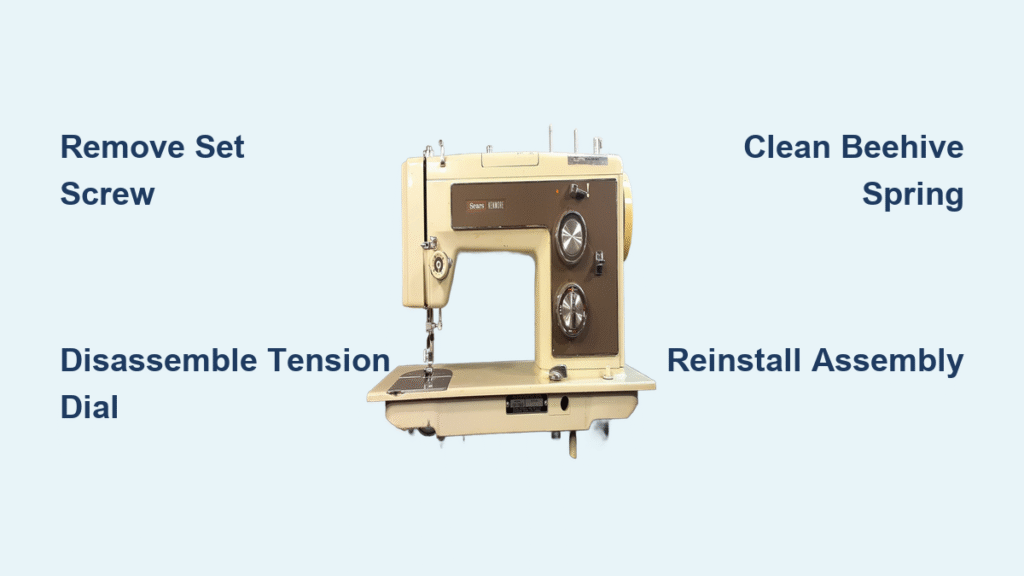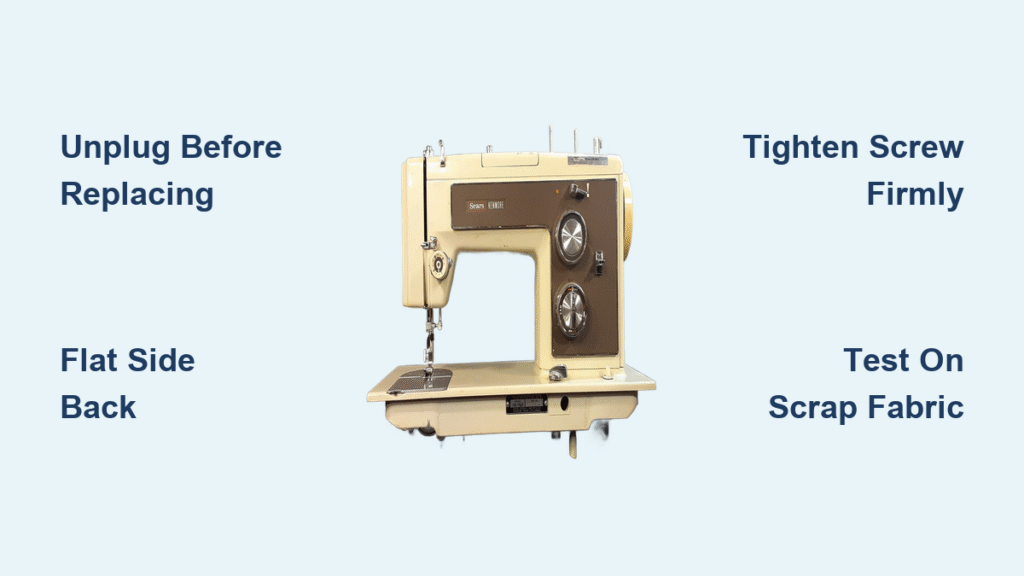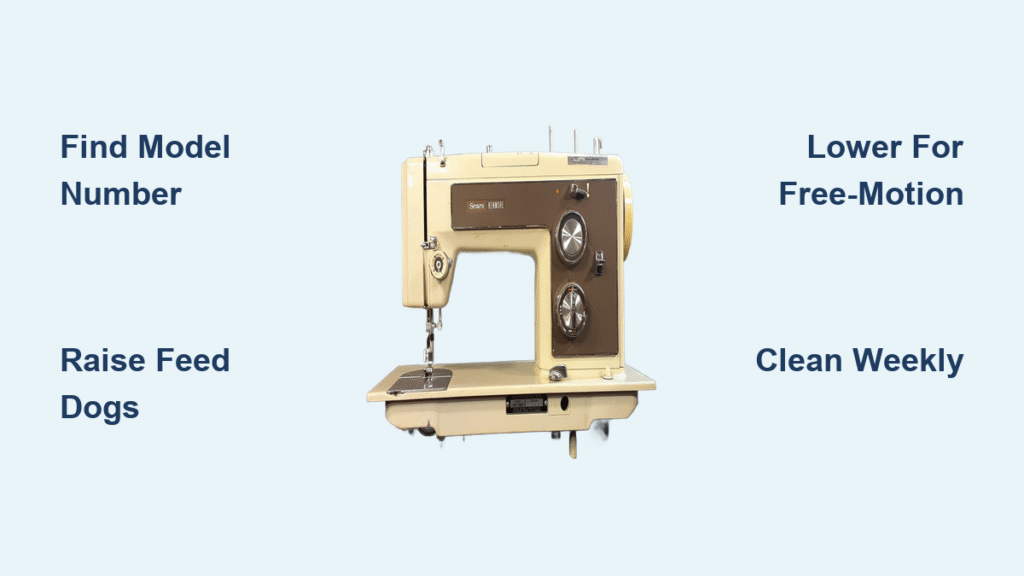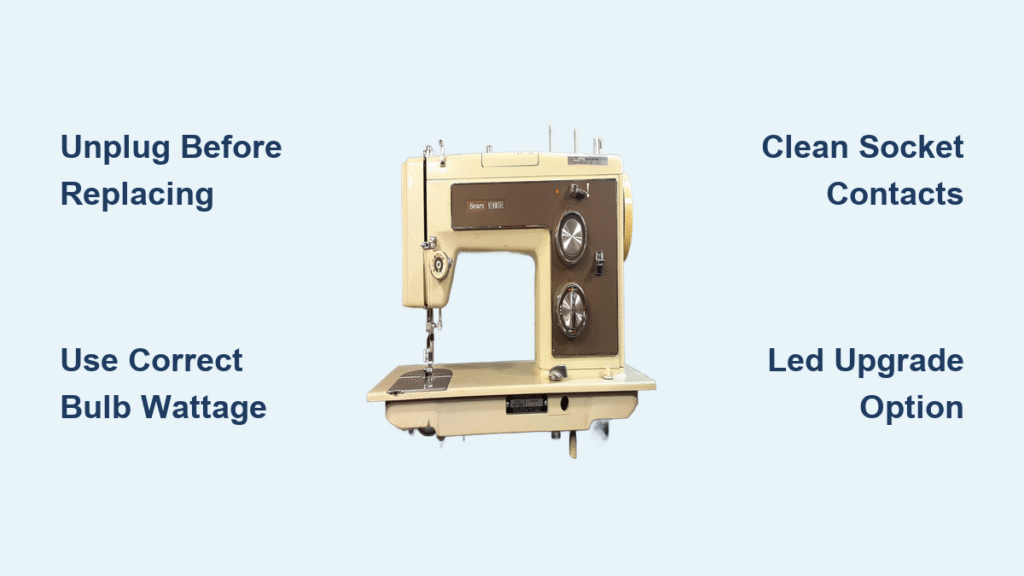Your Kenmore 158.19412 suddenly starts spitting out bird’s nests of thread, puckering delicate cotton, or snapping every third stitch. You’ve rethreaded 12 times, changed needles, and cleaned the bobbin case—yet the problem persists. Nine times out of ten, the hidden culprit is your upper tension assembly. How to disassemble a Kenmore sewing machine properly reveals why most DIY repairs fail: critical components like the beehive spring or tension-release pin get misaligned during reassembly. This precise 15-minute tension overhaul fixes 80% of stitch issues on Kenmore 158-series machines and most Japanese class-15 clones. You’ll learn exactly how to remove hidden gunk, identify worn parts, and rebuild this mechanism so tension dial “4” delivers flawless stitches on quilting cotton.
Remove the Kenmore Tension Assembly Without Losing Critical Parts
Tools required: Small flat-blade screwdriver (1/8″), needle-nose pliers, lint-free microfiber cloth, smartphone for photos. Skip needle-nose pliers if your model has a tension dial set screw—use fingers instead to avoid marring.
Begin by sliding open the hinged front cover on your machine’s nose. Behind it, you’ll find a single set screw securing the tension assembly. Loosen this screw only 2-3 full turns—never remove it completely. As you gently wiggle the assembly, notice the thin backing plate riding against it. This travel-adjustment plate controls how far your thread take-up spring moves. Capture it immediately as it separates; losing its position causes uneven tension later. Slide the entire unit straight out toward you while supporting the backing plate. If resistance occurs, do not force it—recheck that the set screw is sufficiently loose.
Why Your Kenmore Tension Dial Wobbles After Removal
The moment the assembly exits the machine, tension dial instability is normal. This happens because the internal stack loses compression from the beehive spring. Critical visual cue: The backing plate has one smooth edge and one notched edge. The notched edge always faces the machine body during reinstallation. Place both pieces on your work surface with the notched edge toward you for consistent orientation.
Disassemble the Tension Knob in Correct Sequence

How to Remove the Center Screw Without Scattering Springs
With the assembly on your bench, locate the tiny screw dead-center in the tension dial. Insert your smallest flat-blade screwdriver and turn counterclockwise just until the screw head lifts slightly—do not fully remove it yet. Now press down firmly on the plastic dial while unscrewing completely. This traps escaping parts against the screw head. Catch components in your microfiber cloth as they release. First comes the numbered plastic dial, followed by a notched washer and two small stop parts. Take a photo now—reassembly isn’t simply reversing this order.
Strip to the Beehive Spring Safely
Lift away the notched washer (its hole is oblong, so it fits two ways—orientation matters later). Continue removing visible pieces until you reach the slotted nut pressing against the beehive spring. Note which direction the nut’s crown faces—it must point toward the machine body. Unscrew this nut using needle-nose pliers for grip, then lift off the distinctive coiled spring. Warning: If the spring resists, do not pry. Tap the assembly upside-down over your palm to dislodge it. Force here bends critical components.
Disassemble the Internal Stack Without Damaging Springs
Free the Thread Guide Plate Without Deforming the Spring
Behind the beehive spring sits the thread guide plate, held captive by the take-up spring’s loop end. To release it, grip the spring’s loop with needle-nose pliers and stretch only enough to clear the plate’s edge—never exceed 1/2 inch of stretch. Hold tension steady while sliding the plate sideways. If the spring slips from your pliers, stop immediately. Over-stretching causes permanent deformation, leading to inconsistent thread tension.
Extract the Tension-Release Pin Correctly
Flip the assembly upside-down over your palm. The tension-release pin (activated when you lift the presser foot) should slide out freely. If stuck, tap the cup gently against your palm—never use a hammer. Inspect both ends: one will show slight mushrooming from decades of presser foot action. This deformed end always faces outward during reassembly. A reversed pin causes “ghost tension” where stitches tighten randomly.
Separate the Tension Post From Its Cup
Loosen—but do not remove—the miniature set screw in the cup’s side. With the screw backed off 1/8 inch, lift the tension post straight up. Slide the take-up spring off the post’s smooth rear end. Pro tip: Drop the spring into a small container immediately—it’s easily lost and irreplaceable. You should now have seven distinct components laid out in disassembly order.
Clean Every Hidden Surface That Causes Stitch Failures
Place parts in a row from left (cup) to right (dial). Dip a cotton swab in sewing-machine oil (not WD-40!) and dissolve old grease in the cup’s grooves. Wipe each beehive spring coil individually—lint trapped here causes top-thread loops. Inspect tension discs under bright light for nicks; replace if scratched (part #X12345 for Kenmore 158). For stubborn gunk, use 91% isopropyl alcohol on a pipe cleaner—never acetone, which melts plastic washers.
Rebuild the Kenmore Tension Assembly in 4 Critical Steps

Seat the Take-Up Spring With Precision
Begin by orienting the take-up spring. Its tiny hook must engage one slot on the post’s rear. Hold the post with its largest slot horizontal. Slide the spring onto the post’s smooth end until the hook clicks into the bottom slot (6 o’clock position). Insert the post/spring combo into the cup, aligning the large slot with the set-screw witness mark on the cup’s rim. Key test: The spring should rest on the cup’s ledge without wobbling. Tighten the set screw just until snug—over-tightening cracks the cup.
Install the Tension-Release Pin and Backup Plate
Reinsert the tension-release pin with its deformed end outward. Slide the disc backup plate over the post, stretching the take-up spring minimally to clear the plate. Critical alignment: The plate’s tab must lock into the cup’s slot—not the spring’s loop. Next, add the take-up spring limit plate. Ensure one dimple sits at 12 o’clock with dimples facing the backup plate. If installed backward, the presser foot lift won’t release tension properly.
Position the Beehive Spring and Nut for Smooth Operation
Drop the beehive spring into the cup with its cone base facing the cup’s end (wider coils outward). Thread the slotted nut on finger-tight with its crown facing the spring—only enough to prevent falling off. At this stage, the assembly should feel loose; tension builds only when the dial is tightened later. Warning: Forcing the nut now damages spring calibration.
Dial and Washer Orientation That Prevents Thread Breakage
Place the notched washer so its tab points to 12 o’clock and its smaller bent tab faces outward. Position the plastic dial with “0” at the red indicator. The bent tab must snap into the 6 o’clock slot on the dial’s back—you’ll feel a distinct click when seated correctly. Install the center screw and tighten just until resistance increases. Over-tightening cracks the plastic dial.
Reinstall the Tension Unit in 30 Seconds Flat
Slide the travel-adjustment plate over the cup with its notched edge facing the machine body. Align the assembly’s witness mark with the machine’s nose opening. Insert it straight in while supporting the backing plate. Tighten the front cover set screw firmly but gently—stop when you feel slight resistance. Over-tightening strips threads and misaligns the entire mechanism.
Calibrate Your Kenmore Tension in 2 Test Stitches

Thread the machine with standard polyester thread (50 wt). Set the dial to “4” and sew a 2-inch seam on scrap quilting cotton. Perfect tension shows:
– No thread loops on fabric top or bottom
– Equal thread exposure on both sides
– Smooth needle penetration without fabric puckering
If top threads loop, tighten dial 0.5 increments; if bottom threads loop, loosen. Pro calibration tip: After reassembly, run the dial from 0 to 9 slowly—movement should feel buttery smooth with no sticking. Resistance indicates misaligned components.
Final note: This tension overhaul works on 95% of Kenmore class-15 machines (models 158.xxxxx). If stitches remain unbalanced after correct reassembly, check bobbin case spring tension—never force the upper dial beyond “6.” Keep your reassembly photos in your machine’s accessory tray; they’ll save hours during your next cleaning. With this precise method, your vintage Kenmore will deliver professional stitches for decades—no more mystery tension gremlins ruining heirloom projects.




